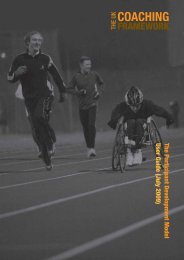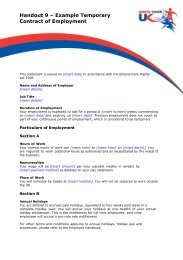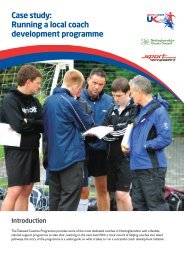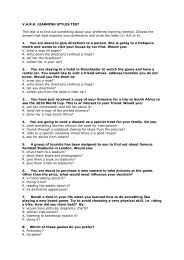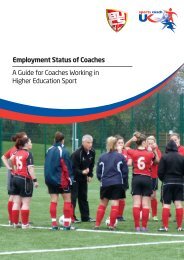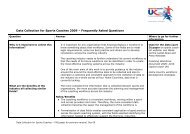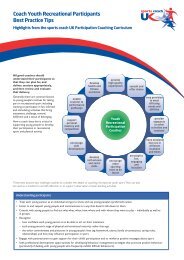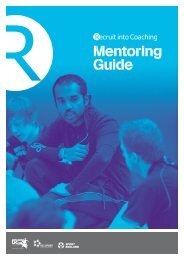Creating a Mentoring Programme for Sport: A ... - sports coach UK
Creating a Mentoring Programme for Sport: A ... - sports coach UK
Creating a Mentoring Programme for Sport: A ... - sports coach UK
You also want an ePaper? Increase the reach of your titles
YUMPU automatically turns print PDFs into web optimized ePapers that Google loves.
<strong>Creating</strong> a <strong>Mentoring</strong> <strong>Programme</strong> <strong>for</strong> <strong>Sport</strong>13discrete tasks or proficiencies and whether this willinclude the tacit knowledge that underpins the role.3 The Reflective Practitioner Model is based onthe premise that mentees learn best when theyself-reflect and critique their own per<strong>for</strong>mance.This is typically done through structuredquestioning and is considered a valuable way <strong>for</strong>individuals to analyse and evaluate practicalexperience, enabling them to subsequently learnfrom it. The role of the mentor in this model isto question the mentee in such a way as tostimulate reflection. However, this model is notgenerally liked by mentees because of itsdemanding nature. Inexperienced mentees don’tseem to like this approach because they have towork and are not just given the answers.StructureMarshall (2001) 5 identified three mentoring modelswith regard to structure: supervisory (<strong>for</strong>mal);in<strong>for</strong>mal; and facilitated. Each <strong>for</strong>mat falls along acontinuum, from those that are very short term andin<strong>for</strong>mal to highly structured, long-term partnerships.1 Supervisory or <strong>for</strong>mal mentoring usually takesplace in a work environment and is consideredto be a function of a supervisor’s duties. This<strong>for</strong>m of mentoring predominantly relies on theability of the supervisor to communicateknowledge about the job. This model could beproblematic in that there is an element ofline-management responsibilities withinthis relationship.2 In contrast, in<strong>for</strong>mal mentoring is based onthe natural pairing of two individuals,characteristically based on some <strong>for</strong>m of mutualchemistry and trust, and typically initiated by thementee. They would typically select an individualwho they felt could assist them in theirdevelopment and work with them accordingly.3 Facilitated mentoring attempts to replicate andbuild on the benefits of in<strong>for</strong>mal mentoring. Thismodel is typically based around a morestructured design incorporating a strategicallyplanned mentoring programme, facilitatedmatching, developmental training, a no-faulttermination culture, a <strong>for</strong>malised careerdevelopment plan and a programmecoordinator whose primary roles are toimplement the programme, match the pairs andmonitor progress and evaluate.RelationshipYoung et al. (2005) 6 identified three relativelydistinct but general patterns in the fundamentalnature of the relationships between mentors andtheir mentees:1 Directive – The directive mentor takes charge,sets the agenda, has a clear expectation <strong>for</strong>mentee per<strong>for</strong>mance and seeks, through avariety of means, to guide the mentee andencourage corrective action. At the extreme, thedirective mentor models specific teachingstrategies and behaviours with the firmexpectation that the mentee will emulate them.Feedback takes the <strong>for</strong>m of strongrecommendations or directives, not suggestionsor possibilities <strong>for</strong> consideration. The directivementor assumes a role of master teacher, guideand sometimes <strong>coach</strong>. This type of mentoringmodel is referred to as hierarchical and is mostappropriate early on in a mentoring relationship,especially if the mentee is a novice in making useof supervision.2 Interactive – In the purest <strong>for</strong>m of thisrelationship, the interactive mentor seeks arough relational parity (equality between thementor and mentee), characterised by openconversation on issues of mutual concern, withthe mentor acting as a friend, colleague andtrusted adviser. Relationships exist only whenthe mentor and mentee recognise each other insome sense as peers, that each brings to therelationship distinctive and valuablecontributions. The agenda is jointly <strong>for</strong>med andadjusted in response to the interests and desiresof either mentor or mentee. This <strong>for</strong>m ofrelationship is most appropriate <strong>for</strong> the moreexperienced mentee and as the mentoringrelationship becomes established.3 Responsive – At the extreme, the responsivementor looks almost exclusively to their mentee<strong>for</strong> guidance and direction. The mentee sets theagenda by posing questions or presentingproblems and concerns <strong>for</strong> the mentor’sconsideration. The object here is to createconditions within which mentees can exercisefull control over the relationship using reflection,empathy and peer-to-peer questioning in orderto generate answers to problems.In practice, effective mentors will move appropriatelybetween the models in relation to purpose,structure and relationship in response to thementee’s needs. Mentors will develop their ownunique style, playing to their strengths and adaptingtheir approach according to the circumstancesof mentees.5Marshall, D. (2001) ‘<strong>Mentoring</strong> as a developmental tool <strong>for</strong> women <strong>coach</strong>es’, Canadian Journal <strong>for</strong> Women in Coaching, 2 (2): 1–10.6Young, J.R., Bullough, R.V. Jr, Draper, R.J., Smith, L.K. and Erickson, L.B. (2005). ‘Novice teacher growth and personal models of mentoring: choosingcompassion over inquiry’, <strong>Mentoring</strong> and Tutoring, 13 (2) 169–188.2




